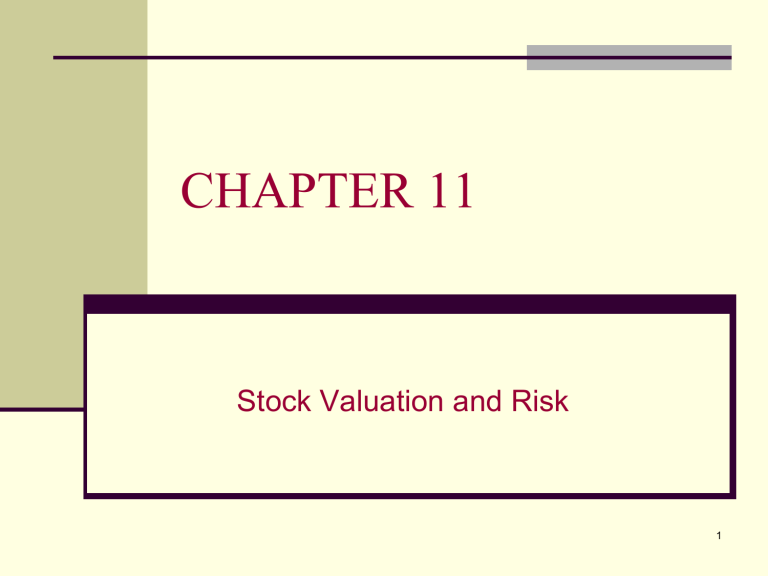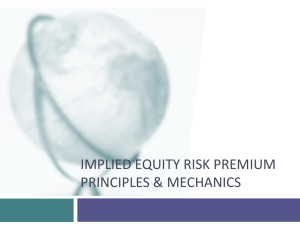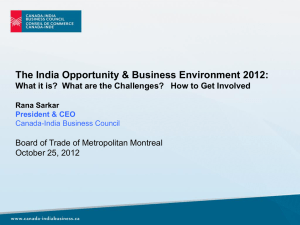CHAPTER 11 - Dr. Leng Ling

CHAPTER 11
Stock Valuation and Risk
1
CHAPTER 11 OVERVIEW
This chapter will:
A. Explain methods of valuing stocks and determining the stock required rate of return
B. Identify the factors that affect stock prices
C. Explain how analysts affect stock prices
D. Explain how to measure the risk of stocks
2
Common Stock Price
For common stock, the future cash flows are:
Dividends
Selling price
These cash flows are highly uncertain.
To find the value of common stock, we make assumptions about how dividends evolve in the future. We look at 3 set of assumptions:
Constant dividend stream
Dividends grow at constant rate (constant dividend growth model)
Non-constant dividend growth
3
Constant dividend stream
Same amount of dividend is paid for ever.
Cash flow stream resembles a perpetuity.
Common stock price, P e
D
P e
r e
Cost of equity capital, r e
Common stock dividend
D r e
P e
Cost of equity capital or required rate of return on equity
4
Dividends grow at constant rate 1
Assume that dividends grow at a constant rate, g, per period forever .
Given this assumption, the price of common stock equals
D
0
= Dividend that the firm just paid P e
D
0
1
g
r e
g
r e
D
1
g
Required rate of return on equity
Dividend growth rate
D
1
= D
0
(1 + g)
5
Dividends grow at constant rate 2
Useful properties.
All other things unchanged,
• If D
0 increases (decreases), P
(decreases).
e increases
•
• If g increases (decreases), P e
(decreases).
increases
If r e increases (decreases), P
(increases).
e decreases
6
Dividends grow at constant rate 2
By rearranging the above equation, we can find the required rate of return on equity
Required rate of return on equity r e
D
1
P e
g Capital gains yield
Dividend yield
For the constant growth model to work, r e
> g.
7
Constant growth problems 1
Jarrow Company will pay an annual dividend of $3 per share one year from today. The dividend is expected to grow at a constant rate of 7% permanently. The market requires
15% What is the current price of the stock (to
2 decimal places)?
In this question D
1 is already given to you.
Verify that Price = $37.5
8
Constant growth problems 2
Johnson Foods Inc. just paid a dividend of
$10 (i.e., D
0
= 10.00). Its dividends are expected to grow at a 4% annual rate forever.
If you require a 15% rate of return on investments of this risk level, what is Johnson
Foods’s current stock price? (to 2 decimal places)
Straightforward application of price formula.
Verify that price = $94.55
9
Constant growth problems 3
The price of a stock in the market is $62. You know that the firm has just paid a dividend of
$5 per share (i.e., D
0
= 5). The dividend growth rate is expected to be 6 percent forever. What is the investors’ required rate of return for this stock (to 2 decimal places)?
Use r e
= (D
1
/P) + g.
Verify that r e
= 14.55%
10
Constant growth problems 4
A firm is expected to pay a dividend of $5.00 on its stock next year. The price of this stock is $40 and the investor’s required rate of return is 20%. The firm’s dividends grow at a constant rate. What is this constant dividend growth rate (g)? use r e
= (D
1
/P) + g
Verify that g = 7.5%
11
Constant growth problems 5
In order to use the constant dividend growth model to value a stock it must be true that: a. The required rate of return is less than the expected dividend growth rate.
b. The expected dividend growth rate is greater than zero.
c. The next dividend (D1) is expected to be greater than
$1.00.
d. The expected dividend growth rate is less than the required rate of return.
12
Non-constant dividend growth 1
With this assumption, dividends grow at different rates for different periods of time.
Eventually, dividends will grow at a constant rate forever.
Time line is very useful for valuing this type of stocks.
To value such stocks, also need the constant growth formula.
Best way to learn is through an example.
13
Non-constant dividend growth 2
ABC Co. is expected to pay dividends at the end of the next three years of $2, $3, $3.50, respectively.
After three years, the dividend is expected to grow at
5% constant annual rate forever. If the required rate of return on this stock is 15%, what is the current stock price?
$2.00
$3.00
$3.50
Dividends grow at 5% forever
T = 0 T =1 T = 2 T = 3 T = 4
14
What to do?
Use constant growth formula to find stock price at the end of year 3. Call this stock price
P
3
.
Add P
3 to dividend received at t=3. This sum is the cash flow for t=3. Find PV of this cash flow.
Find PV of dividends at t=1, t=2.
Current stock price = sum of 2 and 3.
15
Apply the method
P
3
= (3.5 x (1.05))/(0.15 – 0.05) = 36.75
At t=3, cash flow is 36.75 + 3.50 = 40.25
Current stock price,
P
0
2
1 .
15
3
1 .
15
2
40 .
25
1 .
15
3
$ 30 .
47
16
Another type of non-constant growth problem
Malcolm Manufacturing, Inc. just paid a $2.00 annual dividend (that is, D
0
= 2.00). Investors believe that the firm will grow at 10% annually for the next 2 years and 6% annually forever thereafter. Assuming a required return of 15%, what is the current price of the stock (to 2 decimal places)?
Use timeline to ‘see’ the problem better.
Verify that stock price = $25.29
17
Factors That Affect Stock Prices
1. Economic Factors a. Impact of Economic Growth b. Impact of Interest Rates
2. Market Related Factors a. Investor Sentiment
18
Factors That Affect Stock Prices
3. Firm-Specific Factors a. Dividend Policy Changes b. Earnings Surprises c. Acquisitions and Divestitures
19
Stock Market Efficiency
Forms of Efficiency a. Weak-Form Efficiency b. Semistrong-Form Efficiency c. Strong-Form Efficiency
20
Risk & return relationship for equity security 1
To find the risk premium for an equity security, we make use of a theoretical model in finance, called the Capital Asset Pricing
Model (CAPM, pronounced as “cap M”).
21
Risk & return relationship for equity security 2
The CAPM says that the risk premium on equity is defined as: b
(r m
– r f
) tells you how sensitive a stock is to movements in a large, diversified portfolio expected return on the diversified portfolio
22
Risk & return relationship for equity security 3
Required rate of return for an equity security
= risk-free rate + b
(r m
– r f
)
Required rate of return on equity is also known as:
Cost of equity
Discount rate
23
Beta
Measures a stock’s market risk, and shows a stock’s volatility relative to the market.
24
Comments on beta
If beta = 1.0, the security is just as risky as the average stock (the market).
If beta > 1.0, the security is riskier than average.
If beta < 1.0, the security is less risky than average.
Most stocks have betas in the range of 0.5 to
1.5.
25
Calculating betas
Well-diversified investors are primarily concerned with how a stock is expected to move relative to the market in the future.
Without a crystal ball to predict the future, analysts are forced to rely on historical data.
A typical approach to estimate beta is to run a regression of the security’s past returns against the past returns of the market.
The slope of the regression line is defined as the beta coefficient for the security.
26
Illustrating the calculation of beta
.
5 0
-5
-10
20
15
10
5
_ r i
5
.
.
10 15 20
Regression line:
^ r i
^
= -2.59 + 1.44 r
M
Year r
M
1 r i
15% 18%
2
3
-5
12
-10
16
_ r
M
27
Chapter 12
(Stock Market Transactions)
1. Placing an Order a. Market Order b. Stop-Loss Order c. Stop-Buy Order d. Placing an Order Online
2. Margin Trading
3. Short Selling
28
Assignment 7 (continue)
1. Chapter 11
Questions and Applications: 3 4 5 9
Problems: 9 10 11
2. Additional problems
Davidson Company will pay an annual dividend of $6 per share one year from today. The dividend is expected to grow at a constant rate of 15 percent permanently. The market requires 24 percent return on the company. What is the current price of the stock (to 2 decimal places)?
29
Additional problems
The price of a stock in the market is $32. You know that the firm has just paid a dividend of $0.75 per share (i.e., D
0
= 0.75). The dividend growth rate is expected to be 6 percent forever. What is the investors’ required rate of return for this stock?
Brett Creative Media is expected to pay dividends at the end of the next three years of $0.5, $1.5, $2, respectively. After three years, the dividend is expected to grow at a 5% constant annual rate forever. If the required rate of return on this stock is 10%, what is the current stock price?
30









